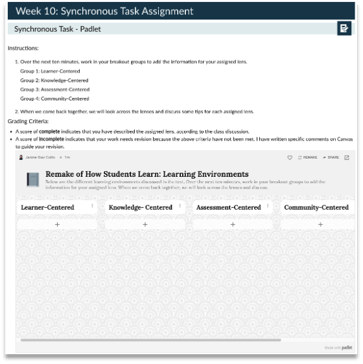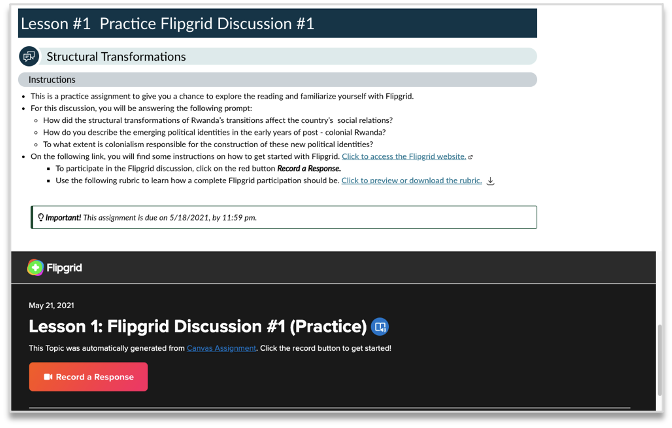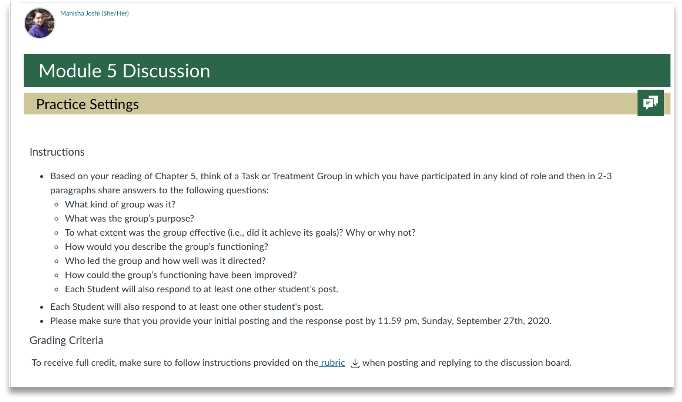 Written by: Janine M. Diaz-Cotto // Aug 18, 2021
Written by: Janine M. Diaz-Cotto // Aug 18, 2021
Last updated: Aug 20, 2021
At the beginning of a new semester, higher education faculty consider the best approaches for promoting collaborative experiences in the online environment. Collaboration is critically important to the learning process and promoting these experiences online can help to reduce isolation, promote class community, and increase all forms of interaction. In fact, with just a few simple course design-related strategies, faculty can easily facilitate collaboration and ensure a more meaningful and robust experience for online learners.
Develop Measurable Learning Objectives
Developing measurable learning objectives is one of the cornerstones that influences online collaboration. Whether your learner is online or face-to-face, it is crucial that your learning objectives are clear and easy to understand. As a result, learners will know what is expected of them during each collaborative experience. Establishing measurable learning objectives will also guide the strategies you use to build your learners’ online collaborative experiences.
Establishing non-measurable objectives could result in the creation of arbitrary activities and assessments that do not measure your learners' achievements. One of the simplest ways to approach the task of developing measurable learning objectives is to ask yourself: What should learners be able to do by the end of this experience? How will they be able to demonstrate what they’ve learned through collaboration? Then, consider how you’d like your learners to communicate and interact with their peers. With that in mind, let’s talk about netiquette.
Establish Netiquette Guidelines
Many of us have had experiences with peers that have been less than kind or respectful. In the online environment, netiquette guidelines can be an effective way to promote safe, respectful, and inclusive interactions online, but how do you establish them? The first step is considering the types of interactions that will take place within your online community. For example, in a synchronous online course, students may talk to each other – either in large or small groups using audio and/or video – and communicate through chat, among other options. However, in an asynchronous online course, students might send emails, participate in online discussions, blogs, and more. It’s essential to set clear guidelines before collaboration occurs. Some students may be used to face-to-face interactions that occur more organically. In the online environment, these opportunities should be considered in advance to encourage safe and respectful dialogue. Netiquette guidelines will help to ensure professionalism, confidentiality, and effective online communication when working with peers.
Give Learners Enough Time to Collaborate

One of the most common complaints from online learners is that there isn't enough time allotted for them to complete collaborative assignments. If you’re facilitating collaborative experiences during a live online session, prepare an agenda in advance and be sure to allot time for each activity you’ve planned. In asynchronous experiences, ensure that you distribute the workload equally and consider the amount of time it will take for learners to coordinate, collaborate, and submit the assignment. Be sure to plan ahead for collaborative experiences and include time for unexpected technical difficulties.
Provide Technical Support
As faculty, it’s critical to consider the potential technical issues that students may encounter while interacting with various online tools and technologies. Giving learners visible locations where they can get technical support can mean the difference between an effective online collaborative experience and a frustrating one. USF offers IT support to all students and faculty when using various online tools (e.g. Microsoft Teams, Canvas, etc.) If you’re planning to use additional resources to promote your collaborative experiences online, be sure to provide learners with tutorials and guides that will help them interact with these tools. Additionally, plan to include opportunities where students can practice using these tools in a low-stakes setting.
Select the Most Effective Tools for Collaboration
Now, let’s discuss how the selection of tools could affect online collaboration. With all the collaborative tools and technologies available, it could be overwhelming to decide which platforms to implement. When considering which tools to use, make sure you have analyzed your learners, your course objectives, and the features each tool or technology provides. In the example below, USF’s Dr. Katie Tricarico, Instructor II & Elementary MAT Program Coordinator, wanted to encourage learner interaction during synchronous sessions so she created a Padlet board for her learners to illustrate and share ideas with their peers. Learners can use Padlet to collaborate in small groups while also sharing their knowledge with a larger group. Technology should be practical and help to promote learners’ meaningful interactions. This challenges faculty and learning designers in higher education to continue learning new ways of connecting learners to their peers as technology continues to evolve.
Provide Opportunities for Practice
Collaborative experiences in online environment can be facilitated through various online tools and technologies, which often require practice to use. Although it may seem repetitive at times, creating ungraded practice assignments can be extremely helpful for students. The more students use the tool, the easier it will be for them to communicate with their peers.

In the example shown, USF’s Dr. Holly Matthew Dunn, Assistant Professor of the School of Interdisciplinary Global Studies, wanted her learners to collaborate using Flipgrid, an asynchronous, collaborative video discussion tool. The use of practice Flipgrid discussions helped her learners familiarize themselves with the platform while interacting with their peers. Dr. Dunn also created practice assignments using Perusall, an e-reading tool that allows students to collaboratively annotate reading materials. With the support of USF Digital Learning, she developed these online collaborative experiences and promoted them during the first weeks of the course so learners had an opportunity to learn how to use the platforms before completing any graded assignments.
Give Frequent Feedback
Regardless of the modality you choose to collaborate, individual and group feedback will set the tone for improvement. The more comprehensive the feedback, the more likely students are to understand how the quality of their work can be improved. For example, comments can be addressed by using Canvas rubrics or the Canvas Speedgrader features, but is not limited to these tools alone. Online discussions are another option for providing frequent feedback to students. Faculty can create discussions for small groups so students could reach out, connect, ask questions, and help each other. Discussions also allow small groups to collaborate, exchange multimedia, and communicate all in one location. Other tools like Microsoft Teams can be used to create channels for student groups. Channels will help you track the progress of small groups while also allowing learners to ask questions about their group assignments and receive feedback from you. This channel may also allow them to share documents, links, or multimedia they have developed for assignments or assessments. This formative feedback is useful to address student questions, close gaps between performance and learning outcomes, and help students feel confident about their learning experience. Subsequently, as mentor and facilitator, learning about these needs will be helpful in adapting your teaching strategies for future small group activities. What matters most is that learners receive frequent and timely feedback on their work.
Create Real-World Collaborative Experiences
When planning these online collaborative experiences, keep in mind the real-life situations that learners may face in their personal and professional lives. These experiences should be an extension of their knowledge, where they can apply and develop problem-solving skills and other important career competencies. When online collaboration has real-life application, it’s pertinent and meaningful, and prepares learners for the future.
In this example, developed by Dr. Manisha Joshi, Associate Professor in the School of Social Work, students were asked to participate in an online discussion after viewing an interactive presentation. Students interacted asynchronously and shared specific practice settings from their respective fields. In sharing their experiences and learning from each other, students are fully engaged in this type of discussion prompt.
Promote a Sense of Class Community
Collaborative learning opportunities can help foster community and counter potential feelings of disconnection. At the same time, they help students take shared ownership and responsibility for their learning. Successful collaborative learning is dependent on an inclusive classroom community, where students trust and respect each other. Some effective community building strategies include social icebreakers where learners can build rapport and establish safe learning environments, content-related activities where students work together to achieve a shared goal, and strong instructor presence where faculty provide multiple opportunities for students to get to know them. In addition to these strategies, faculty can also promote community building by modeling sensitivity and respect for cultural differences and demonstrating genuine interest in learners’ needs and experiences. To ensure the successful implementation of community building strategies in your online course, be sure to consider your context, the technologies available, and what must be prepared and established prior to students interacting and collaborating with each other as a whole class or in small groups.
With all learning experiences, the interactions that students have with the content, their peers, and the instructor are critically important to their learning process. Collaborative online experiences are not only possible but can even surpass face-to-face experiences when designed thoughtfully. As you prepare for the semester ahead, consider these strategies and how you can promote them in your own online courses to ensure a meaningful and robust experience for your learners.

